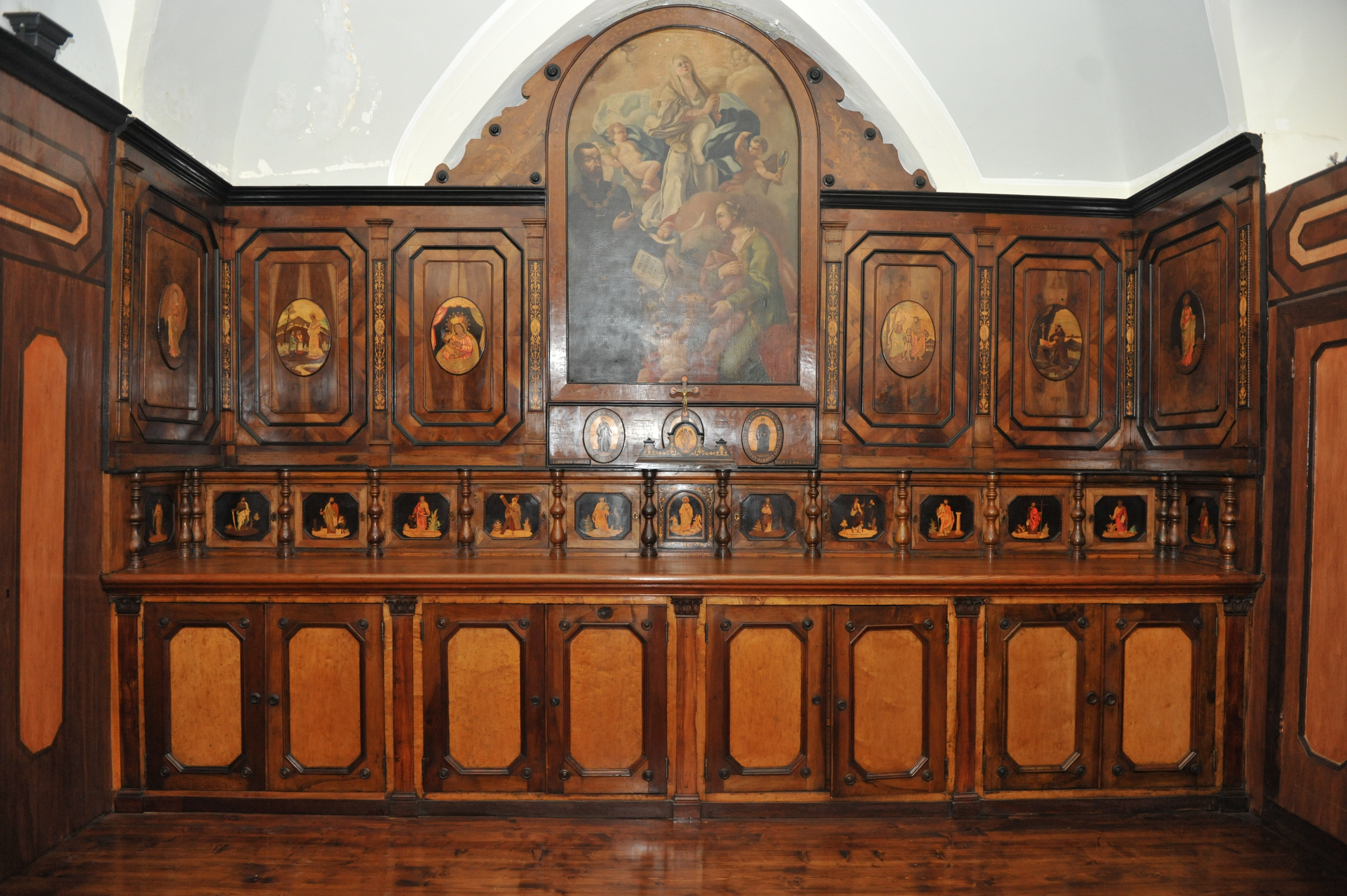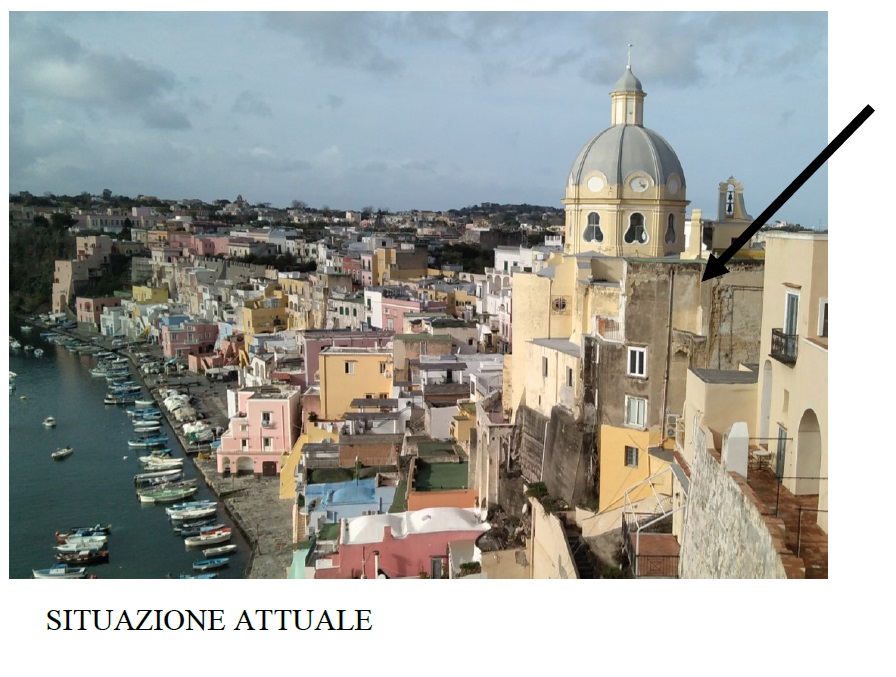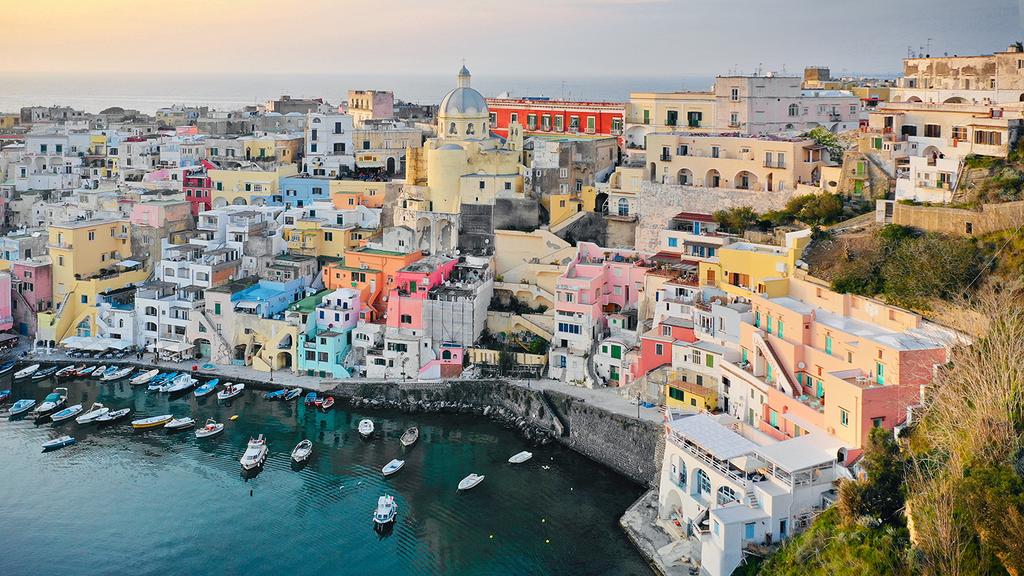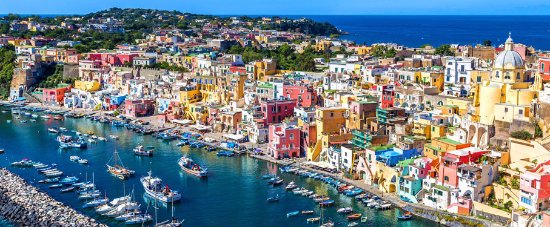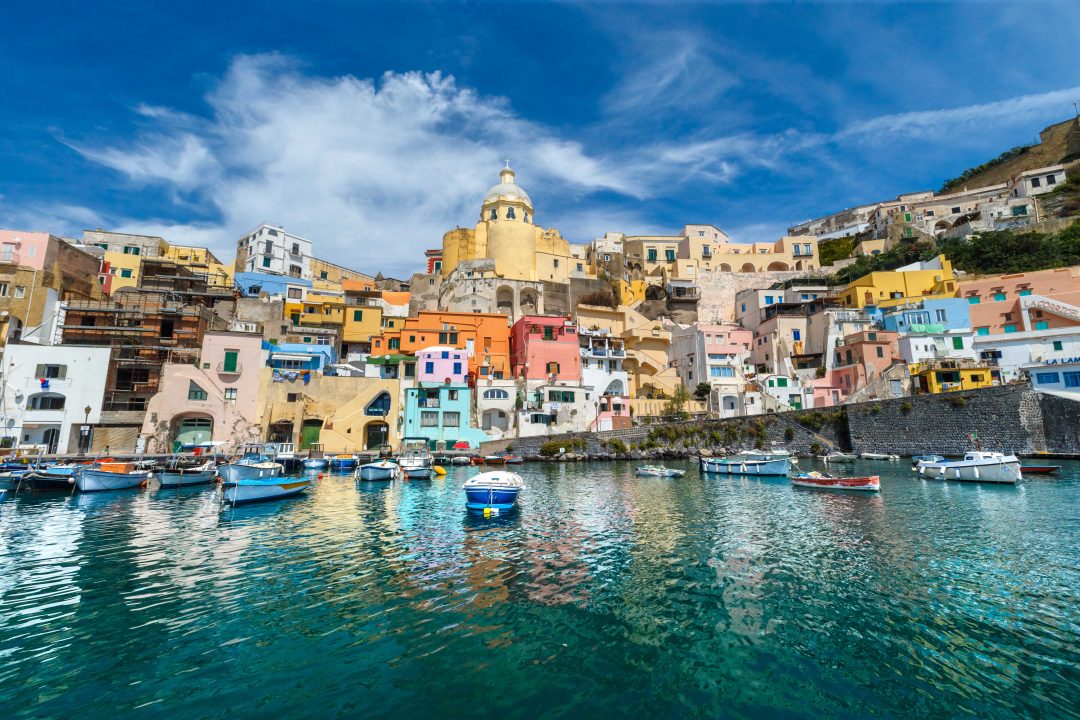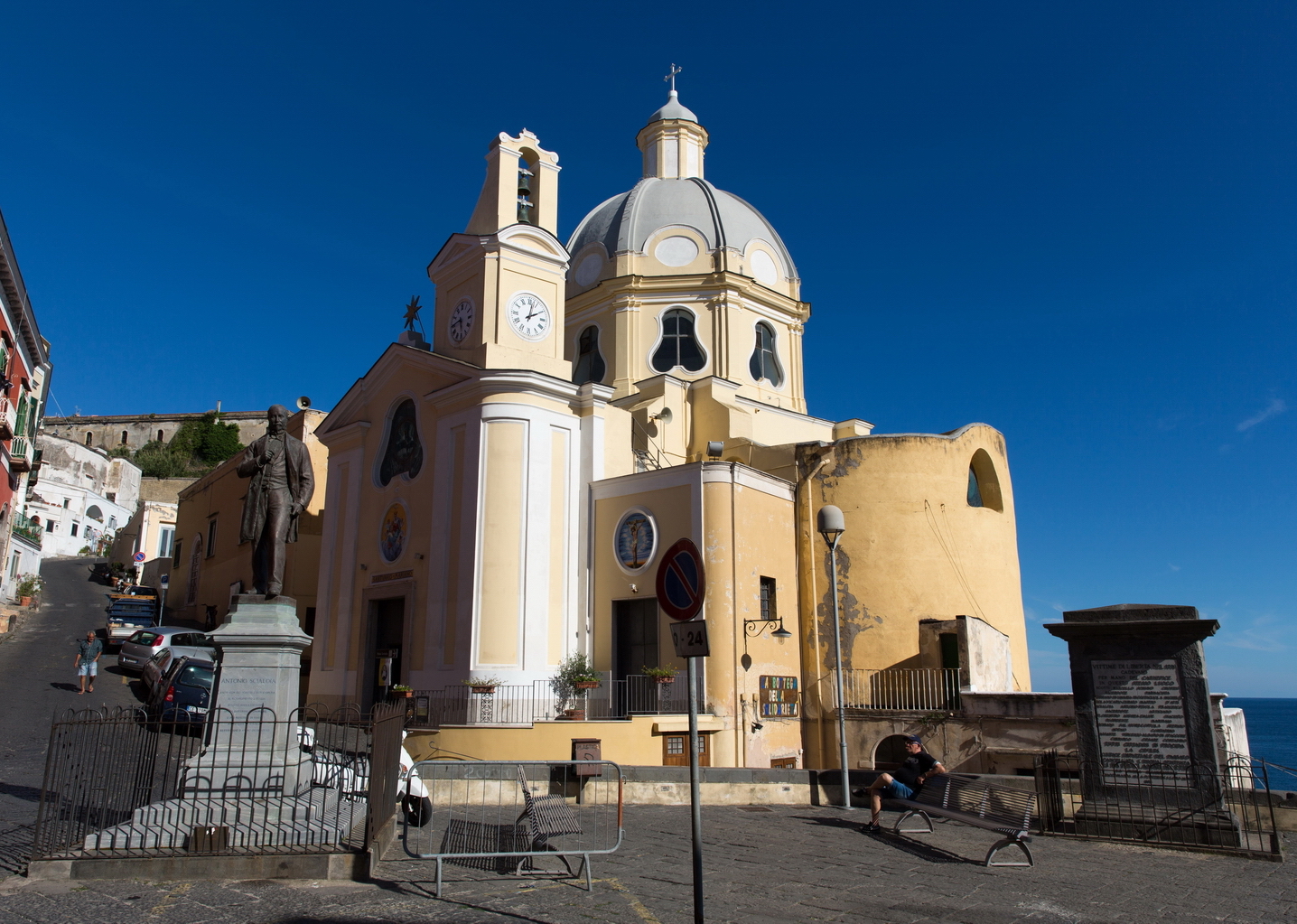
PARROCCHIA S. MARIA DELLE GRAZIE
Mission
Tratte dal libretto composto negli anni ‘80 dal parroco A. Florentino e dal libro “Il 10 Agosto 1924 a Procida” della Prof. Franca Assante (2014)
Si ringraziano coloro che hanno collaborato alla stesura ed alla traduzione
Il Santuario di Santa Maria delle Grazie Incoronata si eleva a ridosso della splendida insenatura che racchiude Marina Corricella, la Marina dei pescatori, e si affaccia sulla storica piazza di “Sammarezio”, la Piazza dei Martiri del 1799, dove furono impiccati i dodici procidani vittime della Repubblica Napoletana.
Come si legge nella “Storia di Procida” di Michele Parascandolo, le prime notizie storiche del Santuario risalgono al 1521, quando c’era una piccola cappella ubicata ai piedi della salita che porta alla Terra Casata (o Murata). All’interno si venerava “una cona di tavola” sulla quale erano dipinti la Vergine, dei candelabri, alcuni voti appesi e una costa di balena.
La Chiesetta fu ampliata nel 1600, ma non ebbe la sufficiente altezza perché i Baroni di Iorio, che abitavano nella torre dirimpetto, lo impedirono per avere più libera la vista del mare e dell’isola. Altre trasformazioni si resero necessarie nel tempo per la particolare configurazione geografica della Chiesa, mentre la maestosa cupola, che troneggia tra il cielo e il mare sullo scenario incantevole di Marina Corricella, fu elevata nel 1928. Nella Chiesa si possono ammirare quattro altari.
L’altare più antico, datato 1732, è quello del Crocifisso, possente scultura lignea di autore ignoto; sulla sinistra si trova quello dedicato a S. Giuseppe, sovrastato da un quadro risalente al 1900.
L’attuale altare maggiore, fatto di sceltissimi marmi e con un bellissimo ciborio, fu consacrato il 26 giugno 1863. Nel 1866 fu costruito l’altare su cui oggi è esposto un quadro della ragazza martire S. Maria Goretti, ma che originariamente era dedicato alla Beata Vergine della Salette, quando era nel pieno fervore il culto delle Apparizioni della Vergine nell’omonima cittadina francese.
L’ultimo altare, risalente al 1867, è dedicato a S. Francesco di Assisi; una vecchia tela ritrae il serafico patriarca nel momento in cui ricevette le stimmate.
La nostra Chiesa ha infatti una tradizione francescana ed era tra le privilegiate per “l'acquisto della Indulgenza” detta della Porziuncola, come si rileva da una lapide del 1881.
In sacrestia si può' ammirare il vestiario, solido ed artistico lavoro di intarsio datato 1890, eseguito da Gaetano Lauro che tramanda le figure di Salvatore e Bernardino Albano (collettori) e di Luigi Perillo (economo). Nel 2015 è stato restaurato dalla ditta MP Restauro di Portici con la supervisione della Soprintendenza. Sulla parete absidale impera una mirabile tela dalla datazione incerta che nel 1854 venne impreziosita di oro e argento come dono che i Procidani offrirono in ringraziamento dello scampato pericolo dell'ondata di colera che aveva colpito il Regno di Napoli.
La tela è stata ridipinta più volte; tenendo in considerazione la vivacità cromatica dell'abbigliamento della Vergine con la soluzione della testa ricoperta dal manto, il colore dell'incarnato e l'ovale perfetto con i lineamenti molto addolciti (caratteristiche della bellezza mediterranea), alcuni sostengono che si potrebbe trattare dell'opera di un allievo di Luca Giordano (M.A. Pavone).
Nel 1998, in seguito al restauro eseguito a cura della Soprintendenza sono stati rimossi il rivestimento e le varie ridipinture, intervento che ha mostrato il parziale di un'altra raffigurazione di mano nettamente superiore a quella visibile precedentemente.
Ogni anno, il manto, agganciato su un foglio di plexiglas, torna ad essere mostrato nel mese di Luglio dedicato alla Madonna delle Grazie.
La devozione dei Procidani verso la Madonna delle Grazie esiste da sempre; il mese di Luglio è il mese della Madonna, è il mese delle Grazie: un richiamo “irresistibile” spinge a correre dalla Madonna. Vedere tanti fedeli, soli o a gruppi, fare sosta a "Semmarezio" per rinfrescare il proprio spirito sul cuore della Mamma e per trasformare la nostra piccola chiesa, in alcuni momenti della giornata, in una cattedrale di preghiera e di lode è fuor di dubbio un "segno di Dio".
La festa principale è la “Visitazione” che secondo il calendario Liturgico si celebra il 31 maggio, ma per i devoti procidani rimane la vecchia data del 2 luglio, fortemente radicata nel cuore e nella mente.
Una data memorabile nella storia della Chiesa è il 10 agosto 1924, quando fu celebrato un solenne Pontificale presieduto dal Cardinale Alessio Ascalesi; alla sacra immagine (alla Madre e al Bambino) vennero apposte due corone in oro purissimo con incastonati trecento brillanti, elaborate dal Maestro Orafo Vincenzo Miranda.
I cronisti dell’epoca scrivono che per tre giorni consecutivi precedenti la domenica del 10 agosto, il sacro rito fu annunciato non soltanto alla popolazione della “grancia”, ma all'intera comunità isolana con il suono a festa delle campane di tutte le chiese.
Nel 1925 la Chiesa fu riconosciuta Parrocchia e nel 1930 divenne Santuario Mariano.
Parrocchia S. Maria delle Grazie incoronata -Piazza dei Martiri 1-80079
Tel 081896 7156 – email: [email protected]
Historical and devotional information
From the work written by the priest A. Florentino in 1980’s and the book “Il 10 Agosto a Procida” by Prof. Franca Assante (2014).
The Shrine of Santa Maria delle Grazie Incoronata is castled on the summit of the splendid inlet of Marina Corricella, the fishing village, and overlooks Piazza dei Martiri (named also “Sammarezio”) where twelve patriots who supported the Neapolitan Republic of 1799 were hung.
As you can read in the Michele Parascandolo’s “Storia di Procida”, the history of the Shrine dates back to the 1521, when there was only a small chapel located at the foot of the rise that leads to the village of Terra Murata or Casata. Inside it, there were only a picture of the Virgin, candelabra, ex voto and a whale’s rib.
The church was enlarged in 1600, but it did not receive the right height because of the obstacle of the barons Di Iorio who resided in front of it and they wanted to have the total view of the sea and the island.
For its particular geographical position, other changes were necessary along the time; its majestic dome was elevated between the sky and the see only in 1928.
In the Shrine you can see four altars.
The most ancient (1732 ) is that of the Crucifix, a mighty wood sculpture of an anonymous author; on the left there is the altar dedicated to St. Joseph with a picture of XX century.
The main altar, made by fine marbles and a beautiful pyx, was consacreted on the 26th of June 1863.
In 1866 there was the construction of the altar which nowadays is dedicated to the virgin martir St. Maria Goretti, but it was originally dedicated to the Blessed Virgin of Salette.
The last altar (1867) is dedicated to St. Francesco d’Assisi with a picture of the Saint in which he is portrayed while he was receiving the stigmata.
Our church has a Franciscan tradition and it was the favourite for the purchase of the so-called “Indulgence of the Porziuncola”.
In the sacristy you can see the mighty artistic inlay work concluded by Gaetano Lauro in 1890; in 2015 it was restored by the company “MP Restauro” situated in Portici.
On the apse, the supreme position is occupied by an old picture without dating; in 1854 it was adorned with gold and silver because the inhabitants of the island wanted to thanks the Virgin for their escaping cholera.
The picture was repainted many times; taken into consideration the colour brilliance of the Virgin’s dress, her head recovered by a mantle, her face’s perfect oval, her ruddiness and soft lineaments, it is possible that it is a work by Luca Giordano’s scholar.
In 1988, after the restoration made by Superintendence, the picture’s covering and its several layers of paint were removed revealing a part of the original decoration.
Every year, in July (the month dedicated to the Virgin) the mantle, which is mounted on a Plexiglas holder, is shown.
The island’s devotion to the Madonna delle Grazie has always existed; July is the month dedicated to the Virgin in which the devotees hurry to the Shrine in order to “refresh” their souls.
The main celebration is the Visitation; according to the liturgical calendar, it is celebrated on the 31th of May, but the date settled in the heart and in the mind of the devotees is on the 2nd of July.
Another important date for the history of the church is on the 10th of August 1924, when the cardinal Alessio Ascalesi placed on the picture, on the heads of the Virgin and the Child, two gold crowns with 300 diamonds, elaborated by Vincenzo Miranda.
As written in the reports of that period, this celebration was announced to the whole island community with the pealing of the bells in each church of Procida.
In 1925 the church was approved as parish and in 1930 was proclaimed Shrine.
Parrocchia S. Maria delle Grazie incoronata -Piazza dei Martiri 1-80079
Tel 081896 7156 – email: [email protected]
Ordina per




